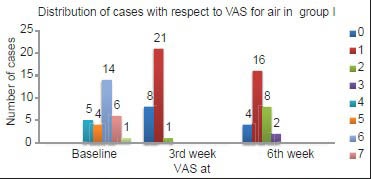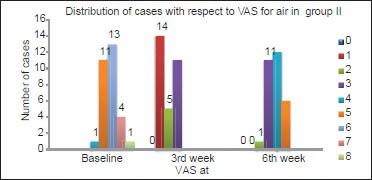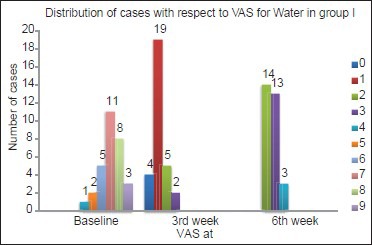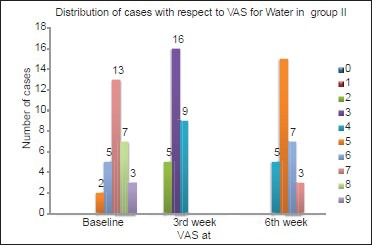Abstract
Background:
Calcium sodium phosphosilicate is a recently introduced desensitizing agent which acts by occluding the dentinal tubules and also resists acid decalcification. This study was designed to assess the efficacy of a new toothpaste containing 5% calcium sodium phosphosilicate for the treatment of dentinal hypersensitivity and also compare it with 5% potassium nitrate.
Materials and Methods:
Sixty patients with the chief complaint of dentinal hypersensitivity were enrolled and randomly divided into two groups. The visual analog scale (VAS) scores were taken for water and air stimuli at baseline, 3 weeks after usage of the respective toothpaste, and 3 weeks after discontinuation of the respective toothpaste.
Results:
Both the groups showed reduction in hypersensitivity scores at 3 weeks and 6 weeks for air stimulus and cold water. The calcium sodium phosphosilicate group, however, showed significantly reduction in hypersensitivity compared to the potassium nitrate group at any time point for both measures of hypersensitivity.
Conclusion:
The 5% calcium sodium phosphosilicate group showed immense reduction in dentinal hypersensitivity symptoms. The 5% calcium sodium phosphosilicate showed prolonged effects even after discontinuation as compared to 5% potassium nitrate, due to its dentinal tubular occlusion property.
Keywords: Calcium sodium phosphosilicate, dentinal hypersensitivity, potassium nitrate, toothpaste
INTRODUCTION
Dentinal hypersensitivity is a common oral complaint that affects the teeth of many individuals. It is defined as “characteristic pain arising from exposed dentine typically in response to a variety of stimuli, for example, thermal, evaporative, tactile, osmotic, or chemical, which cannot be ascribed to any other form of dental defect or ‘pathology’.”[1] A modification to this definition was suggested by the Canadian Advisory Board on Dentine Hypersensitivity (2003),[2] which suggested that “disease” should be substituted for “pathology.” It is reasonable to surmise that with the increasing life expectancy of the population with a functional natural dentition prone to tooth wear, dentinal hypersensitivity is likely to become a more frequent dental complaint and an increase in requests for treatment would thus follow. Yet, conclusive evidence of successful treatment regimens still eludes us despite a multitude of products available for treatment.
Recently, a new material, calcium sodium phosphosilicate, was introduced for the treatment of dentinal hypersensitivity. It acts by chemically reacting with the hydroxyapatite of the teeth and promotes the formation of a hydroxycarbonate apatite layer. It may be useful in treating demineralized tooth structure or in preventing further demineralization.[3]
This study was designed with an aim to evaluate the efficacy of calcium sodium phosphosilicate in the treatment of dentinal hypersensitivity and compare its efficacy with potassium nitrate, which is considered the gold standard for the treatment of dentinal hypersensitivity.
MATERIALS AND METHODS
The study population comprised 60 subjects with the complaint of hypersensitivity. A special proforma was designed for the study, so as to have systematic and methodological recording of all the information and observations. The relevant data comprising the chief complaint, preliminary history, oral hygiene habits, etc., were recorded in the special proforma. Clinical examination was carried out in dental chair under standard conditions of light. The visual analog scale (VAS) is an accepted method of pain measurement. Dentinal hypersensitivity was scored using VAS on air stimulus and cold water stimulus. A VAS scale is a line of 10 cm in length. This line represents the limit of pain a patient might experience from any external stimulus. No pain is represented at one end of the line (marked 0) and severe pain at the other end (marked 10). Subjects were asked to place a mark on the 10-cm line, indicating the intensity of their current level of dentin hypersensitivity.[4]
Cold air blast test
The cold air stimulus was approximately a 1-s blast from the air syringe of the dental unit. The cold air was directed at the exposed surface of the selected tooth that was isolated from the adjacent teeth using cotton rolls. A constant distance (3 mm) was kept between the tooth surface and the tip of the air syringe for the assessment of hypersensitivity. The subjects were asked to rate their response to the stimulus on the VAS scale.[5]
Cold water test
Cold water was taken in a syringe and applied to the exposed dentin surface while the neighboring teeth were isolated during testing using the operator's fingers and cotton rolls.[6] The subjects were asked to rate their response to the stimulus on the VAS scale. A period of at least 5 min was allowed between the two stimuli on each tooth.[7]
After the sensitivity scores were recorded at baseline, scaling and root planing was also carried out. Subjects were then divided into two groups randomly: Group I subjects were given dentifrice containing 5% calcium sodium phosphosilicate and Group II subjects were given dentifrice containing 5% potassium nitrate by the colleague. Subjects were advised to use the toothpaste with a soft bristle toothbrush twice a day. As this was a single-blind study, the operator did not know which toothpastes were given to the subjects. Subjects were also directed to refrain from any other dentifrice or mouth rinse during the trial, but were allowed to continue their normal oral hygiene practice.
Recall
Subjects were recalled after 3 weeks. Hypersensitivity scores were again recorded on cold air stimulus and cold water stimulus as mentioned before. The subjective signs like allergic reaction, burning sensation, ulceration, and taste, and objective signs like redness of mucosa and staining of teeth were also checked at 3 weeks. Subjects were then asked to discontinue the respective desensitizing dentifrices. They were recalled after 3 weeks and the hypersensitivity scores were again taken, i.e. 6 weeks from baseline.
Statistical analysis
Nonparametric tests were carried out due to non-normality of the data. Intra-group analysis was done by Wilcoxon signed-rank test and inter-group analysis by Mann–Whitney U test.
RESULTS
Intra-group analysis
Air stimulus
Fourteen subjects had a VAS score of 6 on air stimulus, which reduced to a score of 1 in maximum subjects (21) after 3 weeks of usage of dentifrice containing 5% calcium sodium phosphosilicate. Also, a VAS score of 1 was maintained by 16 subjects after 3 weeks of discontinuation of dentifrice containing 5% calcium sodium phosphosilicate, i.e. 6 weeks from baseline. Therefore, there was statistically significant reduction of dentinal hypersensitivity between baseline and 3rd week and between baseline and 6th week on air stimulus in Group I (5% calcium sodium phosphosilicate). [Graph 1]
Graph 1.

Comparison of VAS scores at baseline and 3rd week and at baseline and 6th week with air stimulus in Group I (5% calcium sodium phosphosilicate)
Thirteen subjects had a VAS score of 6 on air stimulus, which reduced to a VAS score of 1 in 14 subjects after 3 weeks of usage of dentifrice containing 5% potassium nitrate. Also, the VAS score increased to 4 in 12 subjects after 3 weeks of discontinuation of dentifrice containing 5% potassium nitrate, i.e. 6 weeks from baseline. Therefore, there was statistically significant reduction of dentinal hypersensitivity between baseline and 3rd week and between baseline and 6th week on air stimulus in Group II (5% potassium nitrate). [Graph 2]
Graph 2.

Comparison of VAS scores at baseline and 3rd week and at baseline and 6th week with air stimulus in Group II (5% potassium nitrate)
Water stimulus
Eleven subjects had a VAS score of 7 on water stimulus, which reduced to a VAS score of 1 in maximum subjects (19) after 3 weeks of usage of dentifrice containing 5% calcium sodium phosphosilicate. Also, the VAS score increased to 2 in 14 subjects after 3 weeks of discontinuation of dentifrice containing 5% calcium sodium phosphosilicate, i.e. 6 weeks from baseline. But it was still less than the VAS scores at baseline. Therefore, there was statistically significant reduction of dentinal hypersensitivity between baseline and 3rd week and between baseline and 6th week on water stimulus in Group I (5% calcium sodium phosphosilicate). [Graph 3]
Graph 3.

Comparison of VAS scores at baseline and 3rd week and at baseline and 6th week with water stimulus in Group I (5% calcium sodium phosphosilicate)
Thirteen subjects had a VAS score of 7 on water stimulus, which reduced to a VAS score of 3 in maximum subjects (16) after 3 weeks of usage of dentifrice containing 5% potassium nitrate. Also, the VAS score increased to 5 in 15 subjects after 3 weeks of discontinuation of dentifrice containing 5% potassium nitrate, i.e. 6 weeks from baseline. But the VAS score at 6 weeks was still less compared to the baseline score. Therefore, there was statistically significant reduction of dentinal hypersensitivity between baseline and 3rd week and between baseline and 6th week on water stimulus in Group II (5% potassium nitrate). [Graph 4]
Graph 4.

Comparison of VAS scores at baseline and 3rd week and at baseline and 6th week with water stimulus in Group II (5% potassium nitrate)
Inter-group analysis
Air stimulus
The median1 VAS score at baseline for both the groups was 6. By using Mann–Whitney U test, P > 0.05 was obtained. Therefore, there was no significant difference between Group I (5% calcium sodium phosphosilicate) and Group II (5% potassium nitrate) at baseline [Table 1].
Table 1.
Comparison of air stimulus at baseline with respect to VAS between Groups I (5% calcium sodium phosphosilicate) and II (5% potassium nitrate)

The median VAS score for Group I (5% calcium sodium phosphosilicate) reduced to 1, whereas for Group II (5% potassium nitrate), it reduced to 2 at 3 weeks.
By using Mann-Whitney U test, P < 0.05 was obtained. There was significant difference between Group I (5% calcium sodium phosphosilicate) and Group II (5% potassium nitrate) at 3rd week. Also, the VAS score of Group I (5% calcium sodium phosphosilicate) was significantly lower than the VAS score of Group II (5% potassium nitrate) [Table 2].
Table 2.
Comparison of air stimulus at 3 weeks with respect to VAS between Groups I (5% calcium sodium phosphosilicate) and II (5% potassium nitrate)

The median VAS score of Group I (5% calcium sodium phosphosilicate) increased to 2, whereas for Group II (5% potassium nitrate), it increased to 5 at 6 weeks.
By using Mann–Whitney U test, P < 0.05 was obtained. Therefore, there was statistically significant difference between Group I (5% calcium sodium phosphosilicate) and Group II (5% potassium nitrate) at 6th week. Also, the VAS score of Group I (5% calcium sodium phosphosilicate) was significantly lower than the VAS score of Group II (5% potassium nitrate) [Table 3].
Table 3.
Comparison of air stimulus at 6 weeks with respect to VAS between Groups I (5% calcium sodium phosphosilicate) and II (5% potassium nitrate)

Water stimulus
The median VAS score for both the groups was 7 at baseline. By using Mann–Whitney U test, P > 0.05 was obtained.
Therefore, there was no significant difference between Group I (5% calcium sodium phosphosilicate) and Group II (5% potassium nitrate) at baseline [Table 4].
Table 4.
Comparison of water stimulus at baseline with respect to VAS between Groups I (5% calcium sodium phosphosilicate) and II (5% potassium nitrate)

The Median VAS score of Group I (5% calcium sodium phosphosilicate) decreased to 1 at 3 weeks, whereas for Group II (5% potassium nitrate), it decreased to 3 at 3 weeks.
By using Mann–Whitney U test, P < 0.05 was obtained. There was significant difference between Group I (5% calcium sodium phosphosilicate) and Group II (5% potassium nitrate) at 3rd week. Also, the VAS score of Group I (5% calcium sodium phosphosilicate) was significantly lower than the VAS score of Group II (5% potassium nitrate) [Table 5].
Table 5.
Comparison of water stimulus at 3 weeks with respect to VAS between Groups I (5% calcium sodium phosphosilicate) and II (5% potassium nitrate)

The median VAS score increased to 3 in Group I (5% calcium sodium phosphosilicate) and 5 in Group II (5% potassium nitrate) at 6 weeks, which was still less than the baseline score.
By using Mann–Whitney U test, P < 0.05 was obtained. Therefore, there was significant difference between Group I (5% calcium sodium phosphosilicate) and Group II (5% potassium nitrate) at 6th week. Also, the VAS score of Group I (5% calcium sodium phosphosilicate) was significantly lower than the VAS score of Group II (5% potassium nitrate) [Table 6].
Table 6.
Comparison of water stimulus at 6 weeks with respect to VAS between Groups I (5% calcium sodium phosphosilicate) and II (5% potassium nitrate)

Subjective and objective signs
No untoward reaction was noted with either of the dentifrices.
DISCUSSION
Life expectancy is increasing and patients are retaining their natural teeth for longer time due to effective treatment strategies for caries and periodontal disease.[8] Consequently, there is a high risk of cervical dentin hypersensitivity as a result of physiologic gingival recession with aging. The concept of tubular occlusion as a method of dentin desensitization is a logical conclusion from the hydrodynamic theory.
Calcium sodium phosphosilicate is a recently introduced desensitizing agent which acts by occluding the dentinal tubules and also resists acid decalcification. Burwell et al.[9] concluded in their study that calcium sodium phosphosilicate adheres to an exposed dentin surface and reacts with it to form a mineralized layer and provide continual occlusion of the dentin tubules. Therefore, it is supposed to have a long-lasting effect.
In view of the above observations, in this study, the subjects were asked to discontinue with their respective dentifrices after 3 weeks of usage. The VAS scores were again recorded after 3 weeks of discontinuation, i.e. 6 weeks from baseline.
There was statistically significant reduction of dentinal hypersensitivity between baseline and 3rd week and between baseline and 6th week, on air and water stimuli in both groups. But dentinal hypersensitivity reduction in Group I (5% calcium sodium phosphosilicate) was statistically significant when compared to Group II (5% potassium nitrate) at 3 weeks, i.e. after 3 weeks usage of respective dentifrices on both air and water stimuli. The results of the present study are in accordance with a previous study conducted by Pradeep et al.[10] in 110 patients. The study showed a significant decrease in dentin hypersensitivity at 2 weeks and 6 weeks treatment with calcium sodium phosphosilicate, but with a higher reduction in hypersensitivity score for air stimulus as compared to water stimulus.
It was also observed that there was significant difference between Group I (5% calcium sodium phosphosilicate) and Group II (5% potassium nitrate) at 6th week. Also, the VAS score of Group I (5% calcium sodium phosphosilicate) was significantly lower than the VAS score of Group II (5% potassium nitrate). Therefore, it can be suggested that 5% calcium sodium phosphosilicate has a prolonged effect in managing dentinal hypersensitivity, even after discontinuation, compared to 5% potassium nitrate.
The results of the study show that 5% calcium sodium phosphosilicate dentifrice was comparable to 5% potassium nitrate dentifrice in reducing the dentinal hypersensitivity scores; however, calcium sodium phosphosilicate resulted in better reduction in VAS scores after 3 weeks.
It was observed that the hypersensitivity scores increased over a period of 3 weeks after cessation of use of toothpaste. This may be partially attributed to the gradual reopening of dentin tubules after the withdrawal of desensitizing toothpaste.[11] But the hypersensitivity scores still remained below the baseline scores at the end of the study. The increase in hypersensitivity score with 5% calcium sodium phosphosilicate was significantly less compared to 5% potassium nitrate after 3 weeks of cessation, i.e. 6 weeks from baseline.
Therefore, at the end of the study, better results were obtained with 5% calcium sodium phosphosilicate compared to 5% potassium nitrate.
CONCLUSION
It can be concluded that under the conditions of this study, the group using 5% calcium sodium phosphosilicate showed statistically significant reduction in dentinal hypersensitivity symptoms even after 3 weeks of discontinuing its use. This can be attributed to its dentinal tubular occlusion property.[9] Thus, it can be suggested that 5% calcium sodium phosphosilicate is not only significantly effective but also can also maintain its effects even after its discontinuation. As calcium sodium phosphosilicate showed greater reduction in dentinal hypersensitivity compared to highly efficacious 5% potassium nitrate and also tends to maintain it even after discontinuation, it may provide a new direction for the treatment of dentinal hypersensitivity.
Footnotes
The median of a finite list of numbers can be found by arranging all the observations from the lowest value to the highest value and the middle value is the median.
Source of Support: Nil
Conflict of Interest: None declared.
REFERENCES
- 1.Dowell P, Addy M. Dentine hypersensitivity – A review, aetiology, symptoms and theories of pain production. J Clin Periodontol. 1983;10:341–50. doi: 10.1111/j.1600-051x.1983.tb01283.x. [DOI] [PubMed] [Google Scholar]
- 2.Canadian Advisory Board on Dentine Hypersensitivity Consensus. based recommendations for the diagnosis and management of dentine hypersensitivity. J Can Dent Assoc. 2003;69:221–8. [PubMed] [Google Scholar]
- 3.Jennings DT, McKenzie KM, Greenspan DC, Clark AE. Quantitative analysis of tubule occlusion using NovaMin (Sodium Calcium Phosphosilicate) J Dent Res. 2004;83:2416. [Google Scholar]
- 4.Gillam DG, Newman HN. Assessment of pain in cervical dentinal sensitivity studies, A review. J Clin Periodontol. 1993;20:383–94. doi: 10.1111/j.1600-051x.1993.tb00378.x. [DOI] [PubMed] [Google Scholar]
- 5.Clark GE, Troullos ES. Designing hypersensitivity clinical trials. Dent Clin North Am. 1990;34:531–44. [PubMed] [Google Scholar]
- 6.Tarbet WJ, Silverman G, Stolman JM, Fratarcangelo PA. An evaluation of two methods for the quantification of dentinal hyper-sensitivity. J Am Dent Assoc. 1979;98:914–8. doi: 10.14219/jada.archive.1979.0182. [DOI] [PubMed] [Google Scholar]
- 7.Kumar GN, Mehta DS. Short-term assessment of the Nd: YAG Laser with and without sodium fluoride varnish in the treatment of dentin hypersensitivity – A clinical and scanning electron microscopy study. J Periodontol. 2005;76:1140–7. doi: 10.1902/jop.2005.76.7.1140. [DOI] [PubMed] [Google Scholar]
- 8.West NX. Dentine hypersensitivity: Preventive and therapeutic approaches to treatment. Periodontol 2000. 2008;48:31–41. doi: 10.1111/j.1600-0757.2008.00262.x. [DOI] [PubMed] [Google Scholar]
- 9.Burwell A, Jennings D, Muscle D, Greenspan DC. NovaMin and dentin hypersensitivity-in vitro evidence of efficacy. J Clin Dent. 2010;21:66–71. [PubMed] [Google Scholar]
- 10.Pradeep AR, Sharma A. Comparison of clinical efficacy of a dentifrice containing calcium sodium phosphosilicate to a dentifrice containing potassium nitrate and to a placebo on dentinal hypersensitivity: A randomized clinical trial. J Periodontol. 2010;81:1167–73. doi: 10.1902/jop.2010.100056. [DOI] [PubMed] [Google Scholar]
- 11.Wang Z, Yue S, Sauro S, Chen H, Xing W, Ma X, et al. Effects of desensitizing toothpastes on dentinal tubule occlusion: A dentine permeability measurement and SEM in vitro study. J Dent. 2010;38:400–10. doi: 10.1016/j.jdent.2010.01.007. [DOI] [PubMed] [Google Scholar]


